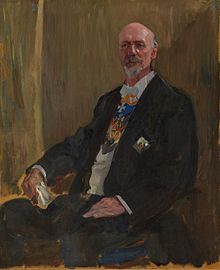Max Jordan

Max Jordan (born June 19, 1837 in Dresden ; † November 11, 1906 in Steglitz ) was a German art historian.
Life
Max Jordan was born on June 19, 1837 in Dresden as the son of the merchant Gottfried Jordan, who founded the Jordan & Timaeus chocolate factory with his brother-in-law Timäus . He attended the Krausesche Lehr- und Erziehungsanstalt and the Kreuzschule in Dresden, where he passed the Abitur in 1855. During this time he dealt intensively with the shorthand systems of Heinrich August Wilhelm Stolze and Franz Xaver Gabelsberger and in 1852 published his "attempt to unite the two German shorthand systems" as a manuscript for his friends. From then on, however, he mainly used Gabelsberger's shorthand for notes, concepts, drafts, excerpts, etc.
From 1856 he studied history at the universities of Berlin , Bonn , Leipzig and Jena, among other things . During his studies in 1856 he became a member of the Teutonia Jena fraternity . In 1859 he was under Professor Johann Gustav Bernhard Droysen with the dissertation "The King of Georg von Podiebrad . A contribution to the history of the development of the state vis-à-vis the Catholic Church ”to the Dr. phil. PhD.
In 1861 Jordan went on a long study trip through Italy, which was decisive for the change of his studies to art history . After returning in the late summer of 1861, he married Agnes Preuss and came into close contact with Gustav Freytag , whom he had already met while studying in Leipzig. In 1864 he joined the editorial team of the Freytag magazine Die Grenzboten .
In the course of the sale of the magazine Die Grenzbote in 1870, he left the editorial office and turned mainly to art-historical work. On March 1, 1871, he was entrusted with the management of the city museum in Leipzig . In 1872 Jordan submitted his post-doctoral thesis investigations into the painter's book by Leonardo da Vinci and has been a lecturer at Leipzig University since then.
In 1874 Jordan was appointed director of the Royal National Gallery in Berlin and five years later a member of the Senate of the Royal Academy of Fine Arts . The Prussian Ministry of Culture awarded him the title of "Lecturer and Secret Government Councilor" in 1880 and that of "Secret Upper Government Council" in 1885.
After the death of his wife in 1895 he resigned from all offices for health reasons. In 1897 he married Hedwig Torges, b. Köppe.
Max Jordan died in 1906 at the age of 69 in Steglitz near Berlin. He was buried in the Old St. Matthew Cemetery in Schöneberg . In the course of the leveling of the cemetery carried out by the National Socialists in 1938/1939, Jordan's remains were reburied in the south-west cemetery in Stahnsdorf ( Trinity block ). The gravestone bears a portrait relief created by Hugo Lederer . The grave is dedicated as an honor grave of the state of Berlin .
reception
In addition to his publications on the old and ancient masters, Jordan also published monographs on Janus Genelli , Julius Schnorr von Carolsfeld and other newer German artists whom he supported and promoted.
Fonts
as an author
- Attempt to unite the two German shorthand systems , Dresden 1852.
- Investigations into the painter's book by Leonardo da Vinci. Leipzig 1873.
as a processor
- History of painting in Italy
- Joseph Archer Crowe , Giovanni Battista Cavalcaselle : History of painting in North Italy. 6 volumes. Leipzig 1869/1874.
- Joseph Archer Crowe: Life of Titian. 1877.
as editor
- National Gallery album.
literature
- Lionel from Donop : Max Jordan. A picture of life . Mittler publishing house, Berlin 1907.
- Rudolf Weinmeister: Max Jordan and his relationship to shorthand, in: Fritz Burmeister (ed.), Writings of the Wilhelm-Stolze-Gesellschaft. Book I, Berlin 1938, pp. 61–71.
- Metzler-Kunsthistoriker-Lexikon , Stuttgart-Weimar 1999, pp. 195–197.
- Helge Dvorak: Biographical Lexicon of the German Burschenschaft. Volume II: Artists. Winter, Heidelberg 2018, ISBN 978-3-8253-6813-5 , pp. 370–371.
Web links
- Literature by and about Max Jordan in the catalog of the German National Library
- Works by and about Max Jordan in the German Digital Library
- Overview of Max Jordan's courses at the University of Leipzig (summer semester 1873 to summer semester 1874)
Individual evidence
- ^ A b c Rudolf Weinmeister: Max Jordan and his relationships with shorthand, in: Fritz Burmeister (ed.), Writings of the Wilhelm-Stolze-Gesellschaft. Book I, Berlin 1938, pp. 61–71.
- ^ Hans-Jürgen Mende: Lexicon of Berlin tombs . Haude & Spener, Berlin 2006. pp. 304, 471.
| personal data | |
|---|---|
| SURNAME | Jordan, Max |
| BRIEF DESCRIPTION | German art historian |
| DATE OF BIRTH | June 19, 1837 |
| PLACE OF BIRTH | Dresden |
| DATE OF DEATH | November 11, 1906 |
| Place of death | Steglitz |
